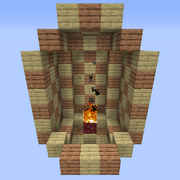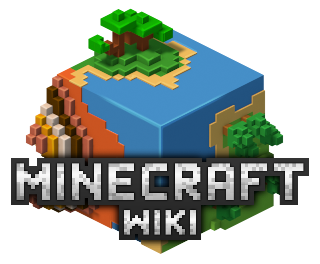| Rinnovabile |
Sì |
|---|---|
| Impilabile |
Sì (64) |
| Attrezzo |
? |
| Resistenza alle esplosioni |
0 |
| Durezza |
0 |
| Luminosità |
Sì, 15 |
| Trasparenza |
Sì |
| Infiammabile |
? |
| Prende fuoco dalla lava |
? |
Il Fuoco è un blocco non solido che produce 15 unità di luce. Ha facce animate su tutti e quattro i lati, ed altre due facce all'interno nella forma di una X. Il fuoco produce un rumore scoppiettante che può essere sentito fino a 15 blocchi di distanza. I blocchi di fuoco sono generati naturalmente soltanto nel Nether e ne La Fine (sulla roccia madre che viene generata sopra i pilastri). Il Giocatore può creare fuoco con un acciarino o una carica di fuoco. I Ghast ed i Blaze possono anche creare fuoco, come può la lava ed i fulmini. Il fuoco si sparge naturalmente ad altri blocchi infiammabili circostanti, e se ottenuto nell'inventario tramite l'utilizzo di un hack può essere piazzato.
Come ingrediente nella fabbricazione
Template:Main Template:Crafting usage
Comportamento

Prima di un incendio

Durante un incendio

Dopo un incendio
Il fuoco non è presente nella modalità Classic. L'acciarino è un metodo per piazzare fuoco nell'ambiente. Quando piazzato, il fuoco brucerà per un tempo determinato casualmente. Se niente di infiammabile si trova vicino ad esso, le fiamme non si spargeranno, ed il fuoco si spegnerà. Questi sono tutti i blocchi infiammabili:
- Legno lavorato
- Lastre di legno
- Legno
- Foglie
- Liane
- Erba alta
- Lana
- Palizzate
- Scale di legno
- Blocchi di carbone
- Blocchi di paglia
- Librerie
I blocchi infiammabili possono bruciare completamente. Se piazzi un letto nell'end o nel Nether e provi a dormirci esploderà e creerà fuoco. Il fuoco può scogliere il ghiaccio, e la TNT esploderà se esposta al fuoco. Il fuoco brucerà le foglie leggermente più velocemente degli altri blocchi infiammabili, indicando che il gioco ha diversi tempi di bruciatura per i diversi blocchi infiammabili (vedi Tick Blocchi per spiegare la casualità nel tempo di bruciatura). I blocchi non infiammabili possono essere accesi ma non bruciano mai completamente e si spengono molto presto. Due blocchi non infiammabili da notare sono la casse e il banco da lavoro.
Mob ed il giocatore prenderanno fuoco quando esposti ad esso. Il fuoco ostruirà parzialmente la visuale del giocatore e perderà lentamente vita al ritmo di ½ cuore a secondo. Questa è la stessa velocità con cui il giocatore recura la vita in modalità pacifica, quindi il fuoco da solo non ti può uccidere in questa modalità. Inoltre, se il giocatore indossa un'armatura di diamante ed ha la barra della fame piena, perderà cuoricini più lentamente stando nel blocco a fuoco che nel stare a fuoco.
Il fuoco può essere utilizzato per danneggiare o ammazzare mob senza renderli ostili al giocatore. Blocchi ed oggetti caduti nel fuoco si accenderanno e molto presto spariranno. Questo trucco può essere utilizzato per distruggere gli oggetti non voluti da un giocatore, ma può anche distruggere oggetti voluti prima che si possano raccogliere. La lava può accendere la dinamite, ma ci può anche mettere molti minuti a fare ciò, quindi di solito c'é abbastanza tempo per otgliere la lava prima che la dinamite si accendi.
Un incendio naturale acceso dalla lava che fluisce nell'albero.
Se una mucca, un maiale, o un pollo muoiono mentre vengono danneggiati dal fuoco, faranno cadere la versione cucinata della propria solita carne; per le mucche bistecche cotte, i maiali costolette di maiale, e per il pollo pollo cotto. Questa funzione può essere utilizzata per evitare di dover cuocere la carne. Con un acciarino, o un'arma incantata con aspetto di fuoco o fiamma, tutta la carne fruttata viene cotta, indi risparmiando il tempo e le risorse per cuocerla.
Spargimento

Struttura al sicuro dal fuoco
Il fuoco si spargerà su superfici infiammabili, lentamente causando tutti i blocchi che può raggiungere a scomparire. Il fuoco può salire sui muri, attraversare pavimenti e soffitti, e passare oltre piccole fessure. Più precisamente, il blocco di fuoco (o lava stanziante) può trasformare qualsiasi blocco d'aria adiacente ad un blocco infiammabile in un blocco di fuoco. Questo può accadere ad una distanza di un blocco al di sotto, uno di lato (includendo di diagonale), e quattro blocchi al di sopra della sorgente originaria del fuoco. Quindi se un giocatore lo sta utilizzando come caminetto, deve fare attenzione.
Estinzione
Il fuoco si spegnerà dopo un po' se lasciato fare, ma il giocatore può spegnere l'incendio il prima possibile per evitare danni. Prendere a cazzotti un blocco infiammato spegnerà la faccia del blocco che viene colpita. Colpire il fuoco con un attrezzo in mano non consuma l'attrezzo. Piazzarre acqua, sabbia, o ghiaia sul fuoco lo spegnerà. Un giocatore può saltare dentro dell'acqua per estinguere le fiamme o può utilizzare un secchio d'acqua come un estintore portatile piazzando l'acqua ai propri piedi spegnendo il fuoco instantaneamente.
Fuoco Eterno
La Netherrack, un blocco trovabile nel Nether, brucierà per sempre se acceso, tranne se spento da lava, acqua o il giocatore. Può quindi essere utile per trappole o come difesa attorno alla casa si un giocatore; anche se il giocatore deve ricordarsi che anche se questo è un metodo molto buono per ammazzare mostri, è anche molto efficace contro i mob passivi ed il giocatore stesso, e qualunque oggetto fatto cadere nel fuoco sarà perso. Netherrack accesa può essere utilizzata come sostituto per le torce. Se un giocatore ha poco carbone, può invece utilizzare la netherrack e un acciarino. Il fuoco di netherrack è più luminoso di quella di una torcia, e può essere spento velocemente. Nota che la pioggia non spegne fuoco di Netherrack.
Anche la bedrock nella Fine brucia eternamente.
Se la regola di gioco doFireTick è impostata a false, il fuoco durerà per sempre fino a quando non spento dalla pioggia o dal giocatore.
Storia
Template:History Template:History Template:History Template:History Template:History Template:History Template:History Template:History Template:History Template:History Template:History Template:History Template:History Template:History Template:History Template:History Template:History Template:History
Curiosità
- Sometimes, in survival when you walk into a fire and then walk out very quickly you will not stay on fire.
- It is possible for lightning to light a surface on fire during thunderstorms, but it will almost immediately be put out by rain. In rare cases in SMP, fire may not get extinguished.
- The texture for fire is not obtained from terrain.png; instead, the fire animation is calculated by code and drawn into the "FIRE TEX" area of the in-memory copy of terrain.png. Water, lava, and portal textures work similarly. This is why texture packs with greater than 16x16 pixel tiles have glitches; the area drawn on is not scaled to fit the larger texture (no longer the case in 1.5).
- Though Wood Planks and logs are flammable, they burn up very quickly, making them nearly useless when making a fireplace, bonfire, etc. The only block that burns forever is Netherrack, along with Bedrock but only in The End.
- On very slow computers, when one sets a fire on the side of a block, logs off, and then logs back into the world, for a brief moment, they will see "FIRE TEX HNST!" instead of the fire animation. Notch confirmed that this was purposeful, and "FIRE TEX HNST!" was translated to "Fire texture, honest!" (no longer the case in 1.5).
- Entities, such as mobs or items, that are on fire do not emit any light (although they themselves appear fully illuminated). They also cannot set blocks around them on fire, even if they are flammable.
- Most players choose not to make fireplaces in wooden houses, due to the fact that fire can burn down wood quickly.
- The fire item is also used for an Undefined Item. This item can occur when a world with items of a mod is played without the mod. This item cannot be placed and will disappear when clicked on.
- If you sprint over fire, the sound will be as if you're walking on wood, also, if you obtain fire with commands, mods, or inventory editing and place it, the sound is also wooden placement.
- A Minecraft forest fire is much less dangerous than a real-life one. Burning trees in Minecraft can only create the usual one-meter fire blocks, as opposed to the multi-hundred-foot flames, convection winds, radiant heat and thrown firebrands that a powerful real-life wildfire can create.
- Passing through a Nether Portal while on fire will no longer show the fire, but you will technically still be on fire.
- Flaming Zombies will set you on fire if they hit you.
- Fire will be animated but not give off light when placed in an item frame.
- If water is placed directly onto fire, the fire will be destroyed with fire particles and the accompanying "wood" sounds.
In Pocket Edition
- In 0.7.0, when fire was readded, parts of the texture were sometimes black or white. This was fixed in 0.7.1.
- Before 0.7.0, being on fire would put 2 transparent orange panels in front of the player's face.
- TNT is not set alight by fire, but rather burns away like normal blocks.
- Skeletons and zombies burning in the daylight are different from zombies and skeletons that walked through fire or took a dip in lava. Where the ones that touched fire/lava are covered in flames, the ones burning in daylight constantly take damage and emit smoke. This was fixed in 0.7.4, where Zombies and Skeletons catch fire on the sunlight.
- Early on, there was a glitch where if lava touched a flammable block, textureless fire would spread around the whole map, burning through everything. This was removed in 0.3.3, and had it's bugs fixed, and was reimplemented in 0.7.0.
- When Fire was removed, it was replaced with a stone-type block called .name. This was changed back into fire when it was reimplemented.
- Before 0.3.3, Fire would appear blank, and was only created by lava.
Gallery
- Grid Fire.gif
An animated GIF image of the default fire texture as of the Redstone Update.
References

